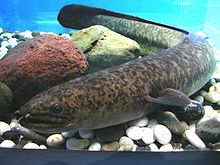Giant mottled eel
| Giant mottled eel | |
|---|---|

| |
| Scientific classification | |
| Domain: | Eukaryota |
| Kingdom: | Animalia |
| Phylum: | Chordata |
| Class: | Actinopterygii |
| Order: | Anguilliformes |
| Family: | Anguillidae |
| Genus: | Anguilla |
| Species: | A. marmorata
|
| Binomial name | |
| Anguilla marmorata Gaimard , 1824 | |
| Synonyms | |
| |
The giant mottled eel (Anguilla marmorata), also known as the marbled eel, is a species of tropical anguillid eel that is found in the Indo-Pacific and adjacent freshwater habitats.[2]
Description

Similar to other anguillids, the giant mottled eel is cylindrical with small, well-developed pectoral fins and a protruding lower jaw.[3] The eel has thick, fleshy lips.[3] The eel has dorsal and anal fins that are continuous around the tail, with the origin of the dorsal-fin between the pectoral fins and anus.[3] It has small, oval-shaped scales that are embedded in the skin.[3]
Unlike some other anguillid species, this species has a mottled color.
It can grow up to 2 meters (6.6 ft) for females and 1.5 meters (4.9 ft) for males and can weigh up to 20.5
Distribution and habitat
This anguillid species can be found from
In 2002, a single eel was captured from a pond close to Kaupo, Maui, Hawaii, though it is not indigenous to the area.[3]
Ecology and behaviour

The adults of this species are
Marbled eels spend their adult lives in freshwater or estuarine habitats, and migrate to the ocean to reproduce.
Feeding
The marbled eel is
Significance to humans

Like other anguillid eels, this species is used as a source of food in some regions.[3] Some restaurants buy live eels.[3] In 1992, for example, a typical 12 kilogram (26.5 lb) marbled eel retailed for one thousand US dollars in China.[3][11]

An eel habitat,
Large individuals of this species are also highly regarded and are not harmed by native people in some island groups of the western Pacific.
References
- . Retrieved 20 November 2021.
- ^ a b c d e f g h i j k Froese, Rainer; Pauly, Daniel (eds.) (2006). "Anguilla marmorata" in FishBase. February 2006 version.
- ^ a b c d e f g h i j k l m n o p q r s USGS. "Anguilla marmorata (fact sheet)". Retrieved 2006-11-21.
- ^ a b c Discover Life. "Anguilla marmorata". Retrieved 2011-06-28.
- .
- .
- ^ McCosker, J. E.; Bustamante, R. H. & Wellington, G. M. (2003). "The freshwater eel, Anguilla marmorata, discovered at Galapagos" (PDF). Noticias de Galápagos. 62: 2–6. Retrieved 21 June 2011.
- .
- .
- ^ ISBN 978-1-86872-643-1. Retrieved 23 June 2011.
- ^ Williamson, Gordon R.; Boëtius, Jan (1993). "The eels Anguilla marmorata and A. japonica in the Pearl River, China, and Hong Kong". Asian Fisheries Science. 6: 129–138.
- ISBN 978-0-470-18191-1.
External links
- ITIS Standard Report Page: Anguilla marmorata
- Encyclopedia of Life: Anguilla marmorata
- Photos of Giant mottled eel on Sealife Collection

